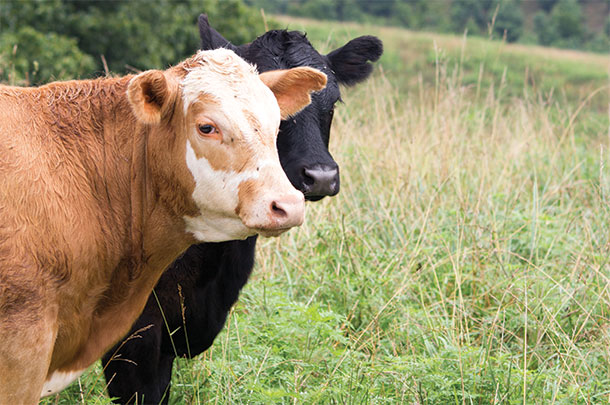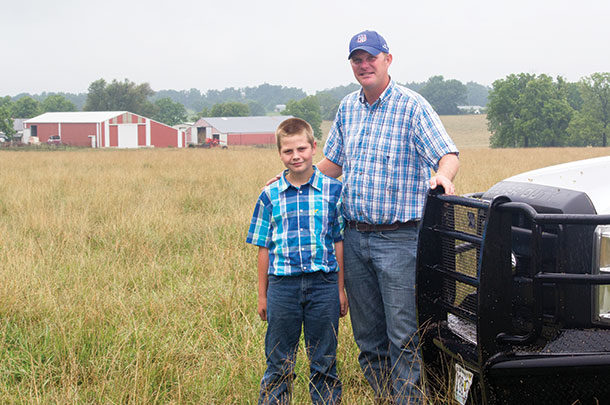Three tenets of his 20-point argument are:
- Training focuses on problems; development focuses on solutions.
- Training adheres to standards; development focuses on maximizing potential.
- Training focuses on maintenance; development focuses on growth.
Myatt says, “Training is something leaders dread and will try and avoid, whereas they will embrace and look forward to development. Development is nuanced, contextual, collaborative, fluid, and above all else, actionable.”
Focus on solutions
Glen Cope of Aurora, Missouri, definitely exhibits qualities inherent to leadership development. That explains, at least in part, why he planted 140 acres of alfalfa in southwest Missouri’s fescue country: He was focused on solutions, maximizing potential and growth.
While the benefits of fescue’s soil-holding capacity, ease of establishment and high tonnage are well-known, Cope was looking for supplemental feed for backgrounding cattle and a better response to potential drought.
A meeting at a neighbor’s farm convinced him to give alfalfa a shot. The alfalfa was planted in June 2014 with a robust establishment that provided two cuttings that year. He saw a difference right away when the hay was fed to the cows; there was no waste because they loved it.
In 2015, Cope bought a bale wrapper to wrap bales from the first cutting, when spring weather was still quite wet. Subsequent cuttings, if weather cooperated, were baled as dry hay and stacked in a barn. Cope says he prefers the dry hay, as there is less plastic to deal with, but admits the wrapper gives them options and flexibility.
Cope is a fourth-generation rancher in the Ozark foothills. With his parents, O.D. and Pam, and brother, Mathew, Cope runs 550 momma cows on a fall-calving system, mostly Angus and Charolais, with some Hereford and Gelbvieh on 3,000-plus acres. Most pastures consist of fescue, orchardgrass, red clover, ladino clover, bluestem and lespedeza.
“Our pastures are large and spread-out, so we use continuous grazing. With the fall calving, the calves are mature enough when the grass hits in April to get compensatory gain,” Cope says.

Through encouragement from University of Missouri beef specialists, the Copes have used timed A.I. to improve herd genetics. Mathew attended a school to learn to preg check and A.I., and when the Copes hire an A.I. technician with a mobile breeding barn, Mathew helps the technician.
To increase weaning weights and condition calves for feedyards, the Copes use creep feeding with a supplement consisting largely of soyhulls. In the near future, they will incorporate alfalfa into the creep-feeding system. Steers are weaned in June at about 715 pounds, directly loaded onto trucks and shipped to a northern Iowa feeder for finishing.
In addition, Cope backgrounds steer calves with the MFA Health Track 45-day program. Cope says, “We want to do anything we can to make the cattle healthier and more attractive to feedlots.” The Iowa feeder also returns the carcass data to help the Copes make adjustments to their operation.
Focus on maximizing potential
Through the example of his parents, Cope learned early in his career that involvement off the farm was as crucial to the success of the ranch as feeding the cows every day. “My parents have always been active in the Missouri Cattlemen’s Association and involved in programs to move the industry forward,” Cope says. Cope and his wife, Leanne, involved themselves early in the Missouri Cattlemen’s Association and in the Missouri Farm Bureau.
Cope participated on the state Young Farmer and Rancher committee and served as chairman in 2010. He became active in the American Farm Bureau and in 2012 became chairman of the national Young Farmer and Rancher committee. His efforts there focused on stopping the EPA’s WOTUS rule, forming the Farm Bill, and changing negative perceptions of agriculture.
“It really broadened my horizons,” Cope says. “I worked with almond farmers and cotton farmers and vegetable farmers, and realized that although the crops may be different, the industries have many commonalities and fight the same issues of over-regulation.”
Cope says he gained relationships with senators and legislators and learned how to be effective with lawmakers. For the last two years, he’s worked with the Missouri Beef Industry Council with the checkoff program in safety development, new product development and other programs.
“It’s important to stay involved in whatever capacity or contact you have in the ag industry,” Cope says. “Sometimes we get in a rut and put blinders on, and the result is that we let others put in restrictive legislation or rules that critically impair our ability to produce. As an industry, we need to make sure our product is in high demand and make sure legislators and consumers understand our industry.”
Focus on growth
Glen and Leanne have two children, Orran and Katie, while Mathew and Michelle also have two children, Skylar and Conner. Looking to their future, Glen is cautiously hopeful and says, “Missouri is an ag-friendly state. Last year, we narrowly passed a constitutional right-to-farm amendment, but it did pass. It hasn’t been tested in the courts yet, so the jury is still out as to what weight it will have.”
But he has concerns about the future profitability of agriculture and bringing youth into the industry. Cope says, “We have to incentivize agriculture with profits. We have to make sure legislation is not passed that will de-centivize ag or make it unprofitable. If it’s not profitable, then young people just aren’t going to come work long, hard hours for no gain.”
Also concerning to Cope are estate tax laws. While ranchers are asset-rich, they’re cash-poor, and in the event of death, property often has to be sold to pay estate taxes, which jeopardizes the financial viability and profitability of the ranch.
It’s this and other legislation and regulations that concern Cope and make him wonder if his own children will have the same opportunities he’s had to return to the ranch.
Development vs. training
Glen, Mathew and O.D. all live on different farms. On most mornings, Glen, Mathew and O.D. look after the cattle on their respective farms, then meet about mid-morning at the main farm to plan the day’s projects and coordinate efforts.
If leadership development is “nuanced, contextual, collaborative, fluid, and above all else, actionable,” then, in light of the mid-morning meeting, it could be argued that leadership development begins at the kitchen table. But the actionable and fluid components are of necessity played out on a much larger stage.
“Training is mechanical; development is intellectual. Training tests patience; development tests courage. Training focuses on the present; development focuses on the future.” (Myatt, Forbes).
If Cope is any indication, the development of agricultural leadership is in good hands. FG
PHOTO 1: Orran and Glen Cope are hopeful for the future of agriculture, hoping it will be adequately incentivized to entice the younger generations to want to “work long, hard hours.
PHOTO 2: Cattle on Cope ranch. Photos courtesy of Lynn Jaynes.











